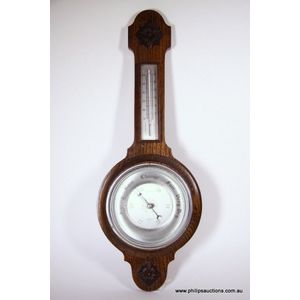Mid-century Oak Wall Barometer with Thermometer
A vintage Shortland Smiths oak cased wall barometer, mid 20th century, England, the banjo shaped compensated barometer and thermometer with a shaped brush steel dial set within a chrome bezel and a framed thermometer set to the arm, the deep toned oak case embellished with applied timber rosettes. Height 29.92 in. Width 11.42 in.
You must be a subscriber, and be logged in to view price and dealer details.
Register Now to view actual auction price for this item.
- Oak - Native to Europe and England, oak has been used for joinery, furniture and building since the beginning of the medieval civilisation. It is a pale yellow in colour when freshly cut and darkens with age to a mid brown colour.
Oak as a furniture timber was superceded by walnut in the 17th century, and in the 18th century by mahogany,
Semi-fossilised bog oak is black in colour, and is found in peat bogs where the trees have fallen and been preserved from decay by the bog. It is used for jewellery and small carved trinkets.
Pollard oak is taken from an oak that has been regularly pollarded, that is the upper branches have been removed at the top of the trunk, result that new branches would appear, and over time the top would become ball-like. . When harvested and sawn, the timber displays a continuous surface of knotty circles. The timber was scarce and expensive and was used in more expensive pieces of furniture in the Regency and Victorian periods. - Bezel - On a clock or watch, the bezel is the metal frame into which the watch or clock glass is fitted. In clocks, the bezel may include a hinge and a flange, in effect a door to the face of the clock. In jewellery the bezel is a band of metal with a projecting lip that holds the gemstone in its setting.
This item has been included into following indexes:
- barometers, period or origin - Edwardian, Art Deco and Art Nouveau 53
-
barometers, type
- banjo 135
- barometers with thermometer 122
